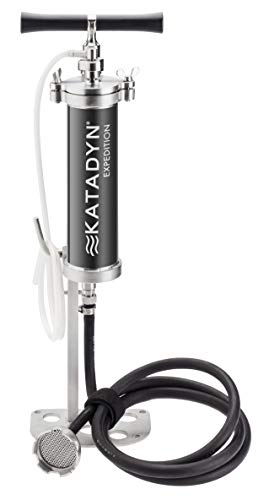Are you prepared for a disaster situation? With potential emergencies looming, it’s important to have a plan in place. Hygiene and sanitation are key components of any survival strategy – critical for staying healthy and preventing the spread of diseases. Let’s discuss how to stay clean and sanitary during a crisis.
We all know that good hygiene practices are critical for our overall health – let alone during times of crisis! And yet, it’s often one of those things that get taken for granted until disaster strikes. In order to ensure success and safety while living through a SHTF event, we must pay attention to proper handwashing techniques, disinfect surfaces regularly, and more.
The great news is that with some prior planning and preparation, it’s possible to maintain safe sanitary conditions even in extreme situations. By following these tips from public health experts who specialize in disaster readiness, you can rest assured knowing your family is as protected as possible against unsanitary conditions or illness due to lack of cleanliness. Read on to learn exactly what steps you should take now so you’re ready if ever faced with an unexpected emergency!
Definition Of SHTF
When SHTF, it’s like a bomb has gone off. Everything is thrown into chaos and all the stability you once knew is suddenly stripped away. In this moment of crisis, survival depends on your ability to maintain sanitary conditions and practice safe hygiene habits.
Hygiene and sanitation are essential for staying healthy in an emergency situation. Germs spread quickly when people don’t have access to clean water or proper waste disposal systems. You need to know how to protect yourself from disease-causing bacteria by using simple steps such as washing your hands regularly and avoiding contact with contaminated surfaces.
Keeping these things in mind can help you remain calm during times of distress and make sure that you stay healthy so that you can be prepared for whatever comes next!
Essential Hygiene Supplies
Now that you understand what SHTF is and its potential consequences, let’s discuss essential hygiene supplies. Hygiene practices are incredibly important when it comes to survival in a SHTF situation as they can help protect against the spread of disease and illness.
When stocking up on hygiene supplies for a SHTF scenario, consider items such as laundry detergent, dish soap, hand sanitizer with at least 60% alcohol content, garbage bags, toilet paper, toothpaste, shampoo/conditioner, feminine hygiene products and disposable gloves. Toiletries may not be as readily available during an emergency so make sure to stock up beforehand. Additionally, try to purchase multi-purpose cleaners like bleach or hydrogen peroxide which can be used to disinfect surfaces throughout your home.
Personal hygiene practices should also become part of your daily routine while surviving in a post-SHTF world. Regularly washing hands with warm soapy water before and after handling food or using the bathroom will help prevent spreading germs and illnesses amongst family members and community members alike. Make sure everyone has access to clean drinking water by boiling any water taken from an unknown source until it reaches a rolling boil for one minute; this will kill any bacteria present in the water. Finally, keep your living area as clean as possible by regularly discarding trash and cleaning surfaces that come into contact with humans or animals. This will keep pests away and create a safe environment for all those around you.
As we move forward into discussing personal hygiene practices specifically tailored for each individual’s needs, remember these basic steps: store extra supplies ahead of time if possible; use multi-purpose cleaners when needed; wash hands often; boil unknown sources of water prior to consumption; discard trash regularly; and keep living areas free of dirt & debris.
Personal Hygiene Practices
The importance of personal hygiene practices is like a lighthouse guiding us through the stormy seas of potential illness and disease. Taking preventive measures to ensure our bodies are clean, well-groomed and cared for is essential in order to maintain good health. Here are some key ways we can protect ourselves from germs and build up our immunity:
First off, washing hands often with soap and water is critical in keeping bacteria at bay. This should be done before eating or preparing food, after using the restroom, after handling animals or their waste, as well as any other time your hands may have been exposed to dirt or contaminants. Additionally, it’s important to keep fingernails short and clean so that germs don’t get trapped under them.
It’s also important to practice proper grooming techniques such as brushing teeth twice a day with fluoride toothpaste; showering or bathing once daily; combing hair regularly; wearing deodorant if needed; changing clothing every few days (especially when sweating); shaving face/body hair (as applicable) etc. All these activities help reduce body odor and prevent skin diseases while improving overall appearance which indirectly helps boost one’s self-esteem too!
Finally, another great way to stay healthy is by getting enough restful sleep each night – at least 7-8 hours for adults – so that our immune systems remain strong and alert throughout the day. Eating nutritious foods including plenty of fruits & vegetables plus drinking lots of fluids helps too! With this combination of simple yet effective personal hygiene habits, we can improve our physical wellbeing immensely! Transitioning now into ‘water sanitation processes’ – let’s look at how we can safeguard against contaminated water sources…
Water Sanitation Processes
Proper water sanitation is a key component of self-sufficient living. It’s critical to keep your drinking, cooking and bathing water clean in order for you to stay healthy during an SHTF event. Here are three important ways to practice safe hygiene and sanitation when it comes to water:
- Boil or Purify Your Water – Boiling or purifying your drinking, cooking and bathing water can help kill bacteria and other contaminants that could make you sick. Boil the water at least one minute before consuming it. Or use chemical cleaners such as chlorine tablets or iodine crystals, following the instructions on the packaging carefully.
- Store Water Safely – Keep any stored water sealed tightly inside containers made from food grade materials like glass, stainless steel or plastic. Make sure that these containers remain upright so they don’t spill in case of an earthquake or other natural disaster. Also check periodically for leaks inside the container itself by looking for drops of condensation along its sides and bottom.
- Dispose Waste Properly – Never dump trash into sources of fresh drinking water; even if something seems small enough not to cause harm, it still adds up over time and pollutes our environment significantly more than we realize! Place all garbage in securely tied bags before throwing them away properly according to local regulations instead of leaving them lying around where animals may get access to them and spread diseases further.
Taking preventive measures with regards to our health has never been more essential than now – especially when dealing with our precious resource: WATER! With careful attention given towards certain processes designed specifically for safely handling this element, we can reduce risks associated with disease transmission while keeping ourselves suitably hydrated for survival situations encountered during crisis events too. Now let’s look at how we can apply similar rules when preparing meals and preserving foodstuffs…
Food Preparation And Preservation Techniques
As the sun rises, it’s time to begin preparing for a long day of survival. One important step in this process is ensuring that food preparation and preservation techniques are practiced with safety and hygiene in mind. This will help keep everyone healthy throughout their journey.
To ensure safe practices when handling food, here’s an overview of some key tips:
| Preparation | Preservation |
|---|---|
| Choose foods suitable for preserving. Be mindful of proper storage temperatures < li >Salt or sugar curing can be used to preserve meat | Choose foods suitable for preserving. Be mindful of proper storage temperatures – Salt or sugar curing can be used to preserve meat |
These simple steps can go a long way towards preventing any potential health issues related to improper food handling. That being said, one should also consider how they plan on dealing with leftovers as well as disposing sewage properly while on a shtf adventure.
Sewage Disposal Systems
Sewage disposal systems are an essential part of keeping our environment safe from disease and contamination. As a prepper, it’s important to be aware of the various types of sewage systems in order to ensure that you can properly protect yourself and your family during SHTF scenarios.
Septic tanks are one type of sewage system used in rural areas where public sewer lines aren’t available. These tanks hold waste until bacteria break it down, then it’s discharged into a drain field for further treatment before being released back into the environment. Keeping septic tanks clean and functional is key to prevent any potential health risks associated with improper disposal of human waste.
Composting toilets are another alternative for off-grid living. They use natural processes such as aerobic decomposition to break down solid waste without the need for water or chemicals. This makes them ideal for low-impact living, but also has its own set of safety concerns due to the fact that pathogens may remain present in composted materials if not handled correctly.
Now that you know about different sewage disposal options, let’s move onto sanitary practices for garments and linens – which include washing all items regularly in hot water with detergent or bleach right away after contact with soil or bodily fluids.
Sanitary Practices For Garments And Linens
Maintaining good hygiene is essential for our health and safety during a SHTF situation. Proper sanitation of garments and linens helps reduce the risk of infection and illness. Here are some key tips to keep in mind when it comes to sanitary practices:
- Wash all clothing items after they have been worn, including underwear, socks and outerwear.
- Use hot water with detergent or bleach if available, as this will help disinfect the fabric. Alternatively, you can also boil your clothes on the stovetop if necessary.
- Hang up any wet laundry to dry in an area that has good airflow – direct sunlight will help kill bacteria too! This is particularly important if you don’t have access to washing machines or other modern amenities.
- Change bed linens regularly by airing them out in the sun each day; use hot water for laundering sheets, pillowcases and blankets whenever possible.
It’s also important to store clean clothes away from sources of dirt or contamination such as dust mites, animal droppings or human waste products. Keep your living space organized so that everyone knows where their belongings belong – this way there won’t be any cross-contamination between people’s items. Remember that garbage should always be disposed of properly to prevent pests from coming into contact with your supplies. By taking these steps we can ensure our environment remains healthy even during tough times.
Having proper sanitary practices in place sets us up for success when it comes time to preventing diseases in a post-apocalyptic world. Let’s move onto exploring disease prevention strategies next…
Disease Prevention Strategies
It’s important to practice safe hygiene and sanitation in order to prevent the spread of disease. The best way to do this is by following basic personal hygiene guidelines, such as washing your hands, disinfecting surfaces and wearing clean clothing. Additionally, it is essential to be aware of disease prevention strategies that can help you stay healthy in an emergency situation.
| Strategy | Description |
|---|---|
| Social distancing | Maintaining a physical distance from others whenever possible. This includes avoiding large crowds or gatherings, staying at least 6 feet away from other people, not shaking hands or hugging and limiting contact with those who are sick. |
| Handwashing | Washing your hands often for at least 20 seconds with soap and water or using hand sanitizer when soap and water are not available. |
| Covering Coughs & Sneezes | Coughing or sneezing into your elbow instead of your hand helps keep germs off your hands where they could potentially come into contact with food, objects or other people. It also reduces the risk of spreading droplets containing viruses through the air which could infect someone else nearby. |
| Disinfection & Sanitation | Regularly cleaning frequently touched surfaces like countertops, door handles, light switches and faucets with household cleaners will help reduce the number of bacteria and virus particles on these surfaces that could potentially lead to illness if transferred onto our bodies. |
| Vaccinations & Immunizations | Getting vaccinated against certain diseases is one of the most effective ways to protect yourself from infection during an emergency situation. Some vaccines require annual boosters while others provide long-term protection after only one dose or two doses over time (e.g., measles). Talk to your doctor about what vaccinations might be right for you before disaster strikes! |
Following these simple steps can help minimize exposure to infectious agents so you’re better able to cope with any potential health risks associated with SHTF scenarios. However, it is equally important to understand how shelter hygiene considerations play an integral role in maintaining overall safety during a crisis too – something we’ll cover next…
Shelter Hygiene Considerations
When preparing for a SHTF situation, it is essential to practice good hygiene and sanitation habits. After all, without proper precautions, the aftermath of a crisis can become even more devastating than the event itself. It’s like trying to put out a fire with gasoline – not only do you fail to douse the flames but now you have an entirely different problem on your hands!
Here are 4 practical tips for maintaining shelter hygiene:
- Cleanliness – Disinfect surfaces daily and don’t forget about items that often get overlooked such as door knobs, light switches and faucets.
- Sanitation – Be sure to use fresh water when cleaning dishes or any other item that comes in contact with food. Toilets should be flushed regularly and emptied if necessary.
- Storage – Store food properly by keeping items off the ground and away from rodents or other pests. All containers used should also be airtight so as not to attract insects or animals in search of food sources.
- Waste disposal – Dispose of human waste safely by burying it at least 6 inches deep into soil or using some type of container system (e.g., bucket toilet) depending on available resources and location regulations/restrictions).
By taking these preventative steps in ensuring hygienic conditions within our shelters during a time of crisis, we can help minimize health risks associated with contaminated environments while creating an environment conducive for mental health maintenance moving forward.
Mental Health Maintenance
When SHTF, maintaining mental health is essential. It can be challenging to keep our minds healthy with all the uncertainty and fear that comes along with a survival situation. To ensure we stay emotionally strong during these trying times, we must focus on self-care practices and stress management techniques.
| Practice | Benefit | How to Do it |
|---|---|---|
| Exercise | Increases energy levels & boosts moods | Take regular walks or runs outside for fresh air |
| Social Connection | Reduces isolation & keeps us engaged in meaningful activities | Connect with friends & family via video calls or text messages |
| Meditation/Relaxation Techniques | Alleviates stress & helps manage emotions more effectively | Learn basic relaxation exercises such as deep breathing, progressive muscle relaxation and guided imagery |
These practices can help reduce tension, promote better sleep patterns, increase our overall sense of wellbeing, and provide control when everything else feels out of our hands. Taking care of ourselves mentally should come first before anything else; if we are not taking care of ourselves internally, everything else will suffer too. So take some time each day to clear your mind and practice emotional mindfulness. You’ll thank yourself later!
Frequently Asked Questions
What Are The Most Common Diseases To Be Aware Of In A Shtf Scenario?
When the SHTF, it’s important to be aware of common diseases that can spread quickly in a survival scenario. This requires knowledge and preparation for prevention measures such as safe hygiene and sanitation practices and an understanding of the symptoms associated with the most frequent illnesses. To get ahead of the game, here is a look at some of the most prevalent ailments to keep on your radar.
First off, gastrointestinal (GI) issues are always top of mind when discussing disease outbreaks during times of crisis. This includes anything from food poisoning to dysentery and salmonellosis – all highly contagious viruses that thrive in unclean environments. Symptoms range from diarrhea and vomiting to abdominal cramps and dehydration so if you start experiencing any of these signs, take swift action by drinking plenty fluids and avoiding contact with others until you have recovered.
Another major cause for concern is respiratory infections like influenza or pneumonia which often spread through contaminated air particles or bodily secretions released into the environment via coughing or sneezing. As soon as you detect sniffles or fevers, put yourself into quarantine while seeking medical attention because failure to do so could mean risking its transmission to other people around you – a recipe for disaster!
In order to stay healthy in a SHTF situation, it pays off big-time to arm yourself with information regarding how infectious diseases operate and what preventive steps need to be taken in order to avoid them altogether. Get educated on proper handwashing techniques, wearing protective gear when handling infected individuals as well as keeping up with routine immunizations that help boost immunity levels so you don’t become another statistic caught up in a vicious cycle. By taking proactive steps now, you’ll be able set yourself up for success later down the line no matter what curveballs life throws your way.
What Are The Best Practices For Personal Hygiene In A Shtf Situation?
Personal hygiene is an essential part of survival during a SHTF scenario. Without proper sanitation and safe practices, disease can spread quickly, leading to further risk for the entire population. Therefore, it’s important to know what the best practices are in order to stay healthy and prevent illness from spreading.
First, wash your hands with soap and water frequently throughout the day. Be sure to use hot water if possible and scrub all surfaces thoroughly before rinsing away any bacteria or viruses that may be present on your skin. Also make sure you dry your hands completely after washing them as wet hands act as breeding grounds for germs. Additionally, keep hand sanitizer handy when access to running water isn’t available – this will help reduce the chances of contagion until you can properly wash up again.
Second, practice good hygiene by keeping your body clean. Take regular showers using warm water and mild soap; aim for at least once every few days if possible and more often in warmer climates where sweat accumulates faster than usual. You should also brush your teeth twice daily with toothpaste containing fluoride – this helps protect against cavities which lead to oral infections or abscesses which could potentially become fatal in certain circumstances without medical aid nearby. Finally, wear loose fitting clothing made from natural fabrics such as cotton or linen which allow air circulation while still protecting from dirt and other contaminants outside of our bodies.
It’s clear then that personal hygiene is key during a SHTF situation in order to avoid illnesses caused by poor health habits such as inadequate handwashing or lack of bathing regularly etcetera. Taking these steps now not only prepares us for times of crisis but provides peace of mind knowing we have done everything within our power to protect ourselves from harm’s way down the line – no matter what comes our way!
What Is The Most Effective Way To Store Water For Long-Term Use During A Shtf Scenario?
When the world as we know it is no longer functioning, having a reliable source of clean water can be the difference between life and death. Storing water for long-term use during an SHTF (Sh*t Hits The Fan) scenario requires forethought and careful planning; but if you get it right, your efforts will pay off tenfold! Even in desperate times, proper sanitation practices are essential to maintaining good personal hygiene, which is why knowing how to effectively store water is so important.
The most effective way of storing water for long-term use involves purification processes that make the water drinkable over time. Boiling or chemical treatment with chlorine tablets are two methods that can successfully rid contaminated water of bacteria and other disease-causing agents. Additionally, filtering through layers of sand and gravel can remove suspended particles like dirt and debris from the liquid. For maximum protection against contamination, airtight food grade containers should be used to store treated drinking water.
Having access to clean water doesn’t just help us survive – it helps us thrive too! In a SHTF situation where resources may be scarce, being able to collect rainwater or melt snow into usable liquid could mean all the difference in keeping yourself healthy and hydrated. With some ingenuity, even small sources of freshwater such as streams or rivers can become purified enough for safe consumption when filtered properly. By taking these steps now while there’s still time, you’ll ensure you’re prepared for whatever comes your way later on down the road!
What Is The Best Way To Preserve Food For Long-Term Use In A Shtf Scenario?
When it comes to long-term use in a SHTF situation, preserving food is essential. Knowing how to store and maintain your food can mean the difference between life or death when resources are scarce. It’s important to be prepared and understand the best ways of storing food so that you have something to eat during an emergency.
Preserving food for long-term use requires careful planning and a variety of methods depending on what type of food needs to be stored. Foods with high water content such as fruits and vegetables should be dried out or pickled while more shelf stable options like grains, nuts, and legumes can be placed in airtight containers. Additionally, using cold storage like root cellars or refrigeration will help keep perishable items from spoiling too quickly.
In addition to these methods, canning is also an effective way of preserving foods for extended periods of time without risking spoilage. By making sure all jars used for canning are properly sealed with tight lids, you can ensure that no bacteria or outside contaminants get into your canned goods. This helps prevent any potential health risks due to contaminated food which could become serious if not addressed promptly during a crisis situation.
No matter what method you choose for preserving your food, being aware of proper hygiene practices is key in ensuring safety and preventing illness during an emergency scenario. Always wash your hands before handling any food product and make sure everything is clean prior to storage in order to avoid any contamination issues down the line. Taking these steps now will ensure that you’re ready whenever you need it most!
What Are The Most Effective Strategies For Maintaining Mental Health In A Shtf Situation?
Maintaining mental health in a SHTF situation is essential for coping with the stress, uncertainty and potential danger that can come along with it. It’s important to remember that though you may not be able to control what is happening around you, there are ways to take care of your own mental wellbeing during this type of difficult time.
The most effective strategies for maintaining mental health in a SHTF situation involve focusing on things within your control. This could include exercising, setting goals, connecting with family and friends (even if virtually) or having some creative outlet like writing or painting. Connecting with nature through activities such as walking outside or gardening can also help relieve stress. Additionally, taking breaks from worrying by doing something enjoyable like playing video games or reading can provide respite from all the chaos around us.
It’s also important to practice self-care by getting enough sleep and eating nutritious meals when possible. Taking part in calming activities like yoga and meditation can help reduce anxiety levels while building resilience and promoting relaxation. If needed, reaching out for professional help is another option worth exploring – talking about how we feel can be incredibly healing and supportive at times like these.
No matter which strategies work best for you, keeping our minds healthy during a SHTF scenario is crucial for our overall wellbeing – physically, mentally and emotionally. Making sure we have access to resources that offer comfort, support and connection will ensure we stay strong throughout whatever challenges lie ahead.
Conclusion
The reality of an SHTF situation is that it can be devastating to our health and wellness if we don’t prepare adequately. Hygiene and sanitation are key to keeping us safe and healthy in such an unpredictable environment. While there is no one-size-fits-all solution when it comes to survival, there are some tried and true practices that many experts agree on. Knowing how to safely store water, preserve food, practice personal hygiene and maintain mental health can make the difference between life and death during a disaster.
We must also remember that although these tips may seem simple enough, they require immense effort and planning to avoid falling into dangerous patterns or putting ourselves at risk. Keeping up with good hygiene habits even during difficult times is crucial for avoiding illnesses like cholera, typhoid fever, dysentery, etc., all of which could lead quickly to death in such scenarios. Furthermore, taking care of our emotional well-being by staying connected with loved ones or engaging in activities we enjoy will help us stay focused on the task ahead – surviving!
Ultimately, learning proper SHTF survival lessons before disaster strikes can mean the difference between life and death. With dedication and discipline, we have the power to protect ourselves from harm while maintaining physical and mental stability under any circumstance. By following best practices for hygiene and sanitation as part of our prepping plan, we greatly increase our chances of making it through whatever lies ahead unscathed.



















